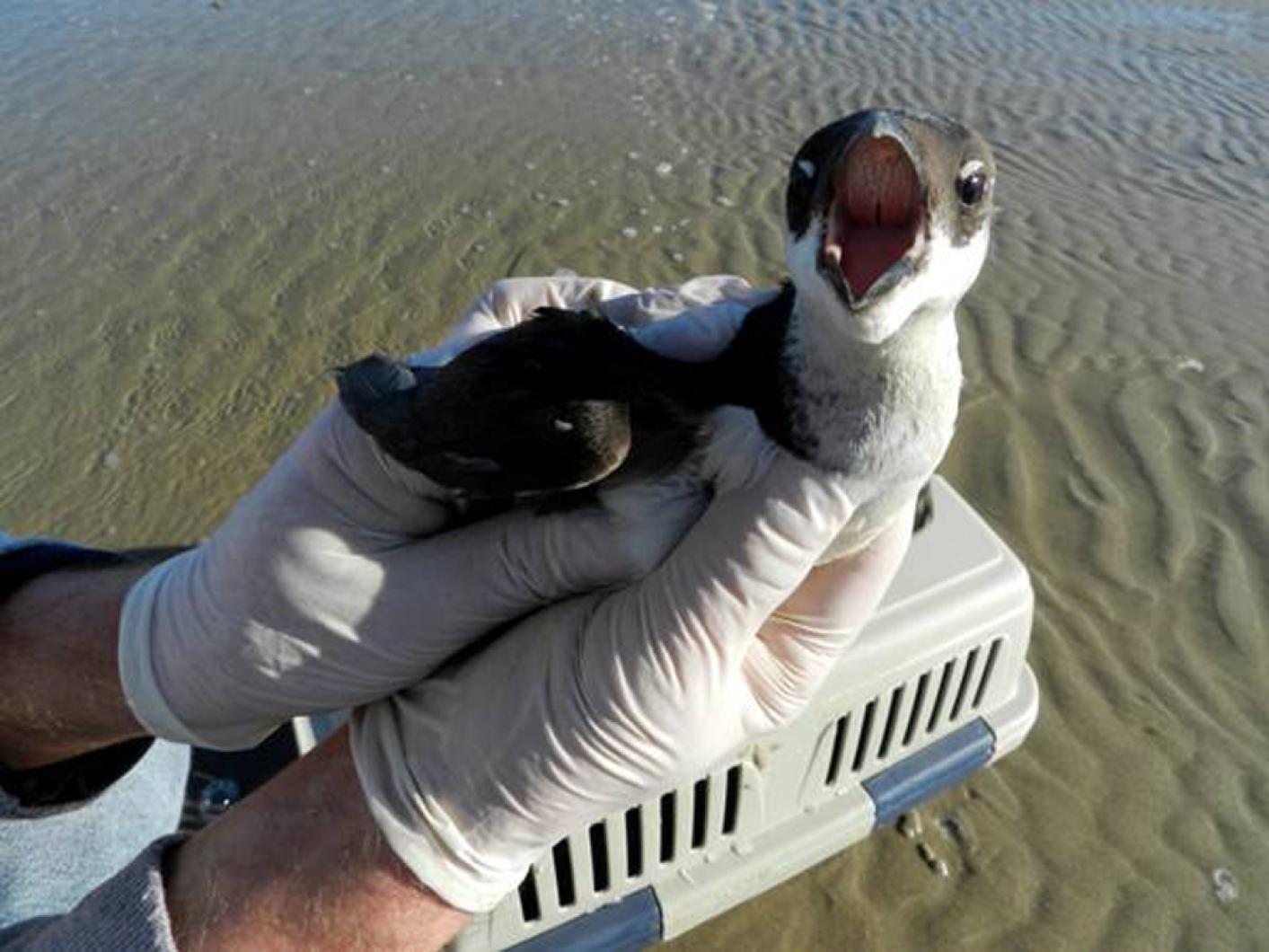There has been a collection of 1960s songs going through my head, so when Wendy Weldon called to say she and James Langlois had found a stranded bird, could I come and tell them what it was and what to do with it, my mind snapped and starting playing Jim Dandy to the Rescue.
Wendy and James had found a small, robust black and white bird that was unable to fly near the Agricultural Hall in West Tisbury. They figured that it had been blown ashore by the gale we had on Friday. Wendy made arrangements to meet at the West Tisbury post office. The bird was not happy being in captivity and was fluttering around trying to escape the hands of the “giant” human holding it. It tried to peck anyone in sight.
The bird was a dovekie. It belongs to a group of birds called alcids, which are considered by many ornithologists as the “penguins of the north.” The razorbills that have been seen and photographed by so many Vineyarders this winter are also alcids and are cousins to the dovekies. I told Wendy that dovekies are not built to be on land and if they get blown ashore they cannot fly. They have to be on water or on the edge of a rocky ledge or cliff to take off. I suggested she take it to Menemsha and put it in the water. Wendy did just that.
She called later to say she the dovekie took to the water and started swimming underwater with its wings. Wendy said she thought both legs were broken as it did not swim with its feet. Alas, no broken legs, just a different adaptation.
Dovekies’ feet, as with all alcids, are located far back on the bird. They use their feet only on land when they are nesting. Dovekies’ legs “float” aft of the bird when they are at sea and are used as a quasi-rudder. They swim with their wings. I checked with Gus Ben David and he agreed with me that if the dovekie swam off, all is well. Gus said many people who find dovekies have the same reaction as Wendy did.
The Cornell Lab of Ornithology researched dovekies and found they “often show up out of range along the east coast of North America and sometimes inland in massive wrecks of stranded, starving birds. Sustained, strong easterly winds have been associated with some of these strandings, most of which have occurred in early winter. Winds likely make feeding conditions unsuitable and push the weakened, emaciated birds landward, although periodic fluctuations in prey availability could also precipitate these strandings. The largest recorded wreck in North America, in the winter of 1932 to 1933, saw dovekies raining down on the streets of New York city and large numbers washed up along the entire eastern seaboard, from Nova Scotia to Florida.” Hopefully the dovekie Wendy released will find plenty of food in Vineyard waters. Dovekies’ food of choice is copepods, amphipods, crustaceans and small pelagic fish. Chances are, and if the razorbills have moved to Vineyard waters because of the abundance of sand eels, the dovekie will enjoy the same.
Bird Sightings
Rob Bierregaard has updated the location of the ospreys that have satellite tracking systems and says Belle is on the Madeira River. Rob expects that Belle will head north in four to five months. Snowy is exploring the Venezuela llanos which will probably dry up shortly so he will probably relocate.
Margaret Curtin birded the head of the Lagoon on Jan. 10 and mentioned that so many birds were singing it sounded like spring. She counted “hundreds of scaup, scores of red-breasted mergansers,” American wigeon, buffleheads, ring-necked ducks, both Bonaparte’s and herring gulls, belted-kingfisher, red-tailed hawk, one red-throated loon and black-crowned night herons.
Bert Fischer spotted and photographed a yellow-breasted chat on Jan. 11 in his grandfather’s backyard at Beetlebung Corner.
Luanne Johnson and Liz Loucks heard a great horned owl while they were working at the Nature Conservancy office off Lambert’s Cove Road on Jan. 11. Katharine Colon spotted a razorbill on East Chop the same day and has had a sharp-shinned hawk pestering the birds at her Skiff avenue, Tisbury home.
Daniel Bangs has been birding since Jan. 5 and spotted northern gannets on the ferry as he crossed. He spotted them again off Menemsha Hills on Jan. 11. On Jan. 10 Daniel found a horned grebe off the Menemsha Hills and a Cooper’s hawk has been harassing the birds at his mother’s feeder near the west basin of the Lagoon in Tisbury. His best bird was a ruddy duck which he sighted by the Corner Service Station in Tisbury on Jan. 2.
Andrew and Nat Woodruff counted at least 15 turkey vultures over Thimble Farm on Jan. 13. Andrew usually sees one or two, but never this many in a flock.
Ginny Jones spotted four eastern bluebirds on Music street in West Tisbury on Jan. 14. The next day Cynthia Bloomquist counted 12 eastern bluebirds on Skiff Lane. No doubt her heated birdbath was the attraction. The bluebirds were joined by two northern cardinals to give quite a splash of color.
Phyllis and Bob Conway spotted two pairs of eastern bluebirds, three turkey vultures and one Cooper’s hawk in the Chilmark yard on Jan. 15. The following day they had five pairs of cardinals and a red-tailed hawk.
Katie Upson spotted an American woodcock at Sepiessa on Jan. 16.
Rob Culbert counted a flock of 25 common grackles in downtown Oak Bluffs on Jan. 17. He also mentioned there were 150 greater scaup in the Lagoon on Jan. 14.
Please report your bird sightings to the Martha’s Vineyard Bird Hotline at 508-645-2913 or e-mail to birds@mvgazette.com. Susan B. Whiting is the coauthor of Vineyard Birds and Vineyard Birds II. Her Web site is vineyardbirds2.com.




Comments
Comment policy »